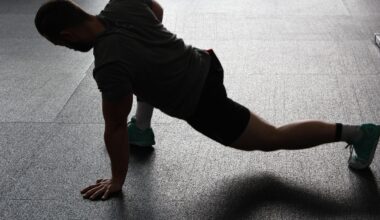Quick Volleyball Stretching Routines for Busy Schedules
Incorporating stretching routines into your volleyball training is crucial. These routines enhance flexibility, reduce injury risk, and facilitate recovery, particularly in a sport requiring explosive movements. Busy schedules can hinder your ability to implement these practices frequently, but quick and effective routines can integrate seamlessly. One essential aspect is preparing your muscles pre-game or practice. Even brief warm-up stretches can significantly affect your performance and overall comfort. Post-game stretches are equally important, serving to relieve tension and promote recovery. As you design your routine, consider using dynamic stretches that mimic volleyball movements. These could include arm swings and high knees that activate muscle groups crucial for your performance. You can perform these stretches quickly, ensuring minimal disruption to your schedule. Additionally, it is essential to focus on major muscle groups like the quadriceps, hamstrings, shoulders, and back. Each routine should only require about 10-15 minutes of your time. In this article, we will explore effective stretches that you can fit into your busy life, helping you stay versatile while maintaining your health and athleticism. Let’s dive into these time-efficient routines.
Dynamic Stretching Routines
Dynamic stretches are vital for athletes, especially volleyball players. These types of movements warm up muscles while keeping them flexible, which is essential for preventing injuries. One effective dynamic stretch includes leg swings, where you stand on one leg while swinging the opposite leg forward and backward. Perform 10-15 swings per leg to loosen your hip flexors and hamstrings. Another great addition is the walking lunges, advancing with each step. This stretch engages multiple muscle groups, improving mobility while preparing for intense play. Additionally, you can add arm circles to the routine. Extend your arms out to the side and make small circles, gradually increasing the size to warm up your shoulders. Do this for about 30 seconds. Incorporating high knees can help improve your coordination and endurance. These moves can be done in a short time frame, making them ideal for busy schedules. Each movement should be gentle yet deliberate, allowing your body to adjust to the intensity. Remember not to rush these stretches; the quality of your movements is more important than quantity, ensuring adequate preparation for your game.
Static stretching also plays a critical role! After matches or training, these stretches help in cooling down and easing tightness. Begin your cooldown with the standing quadriceps stretch. Stand on one leg, pulling the other heel toward your glutes. Maintain this position for 20-30 seconds, feeling the stretch in your thigh. Transition to the seated hamstring stretch, extending one leg straight while bending the other. Reach forward to touch your toe, ensuring your back remains straight. Hold this for another 20-30 seconds. Incorporate shoulder stretches, crossing an arm across your body and gently pulling it into your chest. Maintaining flexibility within your shoulders is crucial for overhead motions in volleyball. Also, add a triceps stretch. By pulling one arm behind your head with the opposite hand, hold for a similar duration. These static stretches should take about 10-15 minutes, promoting recovery and helping avoid soreness. Although they follow your active sessions, the crucial advantage they provide outweighs the time spent. Remember, prioritizing your stretching routine can bolster your performance on the court significantly!
Quick 10-Minute Routine
Here’s a simple 10-minute volleyball stretching routine tailored for busy athletes. Begin with two minutes of high knees to increase your heart rate and warm up the lower body. Next, dedicate another two minutes to leg swings, alternating legs to focus on those hip flexors. Subsequently, move into a minute of arm circles, ensuring a full range of motion. Follow this with two minutes of lunges, alternating sides to engage different leg muscles effectively. Bend forward slightly during this stretch to amplify engagement in your hamstrings. Next, focus two minutes on the standing quadriceps stretch. Finally, conclude the session with a minute each for the seated hamstring and shoulder stretches to enhance flexibility. This entire stretch routine can be a part of your daily commitment to health, making it adaptable to your packed schedule. By consistently incorporating it, you’ll not only improve your flexibility and range of motion but also bolster your overall performance in volleyball games. Regular participation promotes injury prevention, allowing you to work hard and play harder without interruptions.
Incorporating mobility drills into your routine also greatly benefits volleyball players. These drills serve as an excellent addition to both warm-ups and cooldowns. Begin your mobility session with trunk rotations. Stand firmly and rotate your upper body from side to side. Perform this for about 30 seconds. Next, consider ankle mobility exercises to strengthen your base during play; circles and flexes will increase your range of movement. Aligning your footwork is essential for volleyball dynamics. Take two to three minutes practicing transitions between movement patterns. This can dramatically enhance your agility during matches. Incorporating shoulder dislocates using a resistance band can also help improve your overhead performance. Stand with a band in both hands, and gently extend it over your head, moving it back as far as your shoulder’s flexibility allows. With a few minutes dedicated to dedicated mobility exercises, you’ll notice significant benefits in your game overall. Mobility and stretching extend beyond just flexibility; they prepare muscles and joints for movements specific to volleyball, ultimately improving your impact on the court.
Recovery and Stretching
Recovery is as essential as active training in volleyball, and stretching plays a pivotal role in this process. Following an intense session, your muscles may feel tight and fatigued. Implementing targeted stretches helps in alleviating that tension and enhances blood flow to the muscles. This increased blood circulation supports nutrient delivery, boosting recovery rates. Focus on the large muscle groups typically utilized in volleyball—your legs, shoulders, and back. For instance, performing gentle back stretches such as the cat-cow pose aids in spinal flexibility and releases tension. Proceed with a standing forward bend to stretch your lower back and hamstrings effectively. Allocating 15-20 minutes for post-play stretches should become your norm. Emphasize the importance of deep and relaxed breathing during these stretches; inhale deeply, feeling your muscles ease as you exhale. In your volleyball journey, stretching and recovery should not be perceived as secondary tasks; they form the backbone of your training program. Embracing these elements will undoubtedly yield positive results, enhancing your physical performance whilst enjoying the sport.
In conclusion, with busy schedules, it is vital to prioritize stretching routines in volleyball training. This practice not only promotes flexibility but also encourages injury prevention and optimal performance. The routines presented in this article fit seamlessly into a packed lifestyle, enabling dedicated athletes to maintain their edge. Each stretching exercise helps create a well-rounded approach to training, enhancing mobility and flexibility while reinforcing strength. Whether utilizing dynamic moves for warm-ups or static stretches for recovery, each has its place in your regimen. Your commitment to this practice makes a considerable difference, gauging how effectively you can recover and prepare for your next training session or competition. Maintain consistency, and gradually you will observe the positive impacts of these efforts on your overall game. The combination of routine stretching, mobility drills, and mindfulness in recovery can set you apart in the sport of volleyball. Remember that every bit of effort counts in the long run. Stretching doesn’t merely occupy your timeline; it enhances your journey towards becoming a better volleyball athlete. Start integrating these stretches into your routine today!


